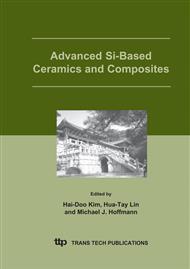p.189
p.194
p.200
p.206
p.212
p.220
p.226
p.233
p.242
Modification of Inner Pores with Silicon Carbide Whiskers onto the Al2O3 Substrate by CVI Process
Abstract:
In this study, SiC whiskers were grown in porous alumina substrate in order to enhance the filtering efficiency, performance, and durability by controlling pore morphology. This experiment was performed by chemical vapor infiltration (CVI) in order to obtain the whiskers on the inside of pores as well as on the surface of porous the Al2O3 substrate. The deposition morphology was changed remarkably with the deposition position and temperature. First, the mean diameter of whisker was decreased as the position of observation moved into the inside of substrate due to ‘the depletion effect’ and ‘the pressure effect’. Second, the deposition temperature caused the changes of the deposition type such as debris, whiskers and films and these changes of morphology affect the various properties. When SiC films were deposited, the gas permeability and the specific surface area decreased. However, the whisker showed the opposite result; a large specific surface area provides the absorption site and the whiskers in gas traveling path hinder the particles from easily flowing. Comparing with the normal pores (inter-grain open pores), the pores formed by the whiskers have relatively large volume fraction under the same pore size. Porous ceramic filters with whisker will be expected to increase the filtering efficient and gas permeability simultaneously. It is the main advantage of our whiskered filter. Therefore the porous alumina body which deposited the SiC whisker will be the promising material in order to apply to the particulate filter.
Info:
Periodical:
Pages:
212-219
Citation:
Online since:
June 2005
Authors:
Price:
Сopyright:
© 2005 Trans Tech Publications Ltd. All Rights Reserved
Share:
Citation:


